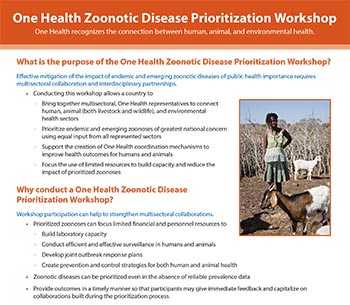Global Activities
Many CDC activities use a One Health approach to better understand the connection between human, animal, and environmental health. In addition to supporting One Health activities in the United States, CDC is involved in One Health activities around the world. Diseases can spread around the world very quickly, so it’s important for CDC to work closely with other countries to build strong partnerships with human and animal health organizations.
Global Health Security Agenda
The Global Health Security Agenda (GHSA) is an effort by nations, international organizations, and civil society to accelerate progress toward a world safe and secure from infectious disease threats; to promote global health security as an international priority; and to spur progress toward full implementation of the World Health Organization (WHO) International Health Regulations 2005 (IHR), the World Organization for Animal Health (OIE) Performance of Veterinary Services (PVS) pathway, and other relevant global health security frameworks.
In order to encourage progress toward these goals, the “Action Packages” concept was developed to facilitate regional and global collaboration toward specific GHSA objectives and targets. All countries that support the GHSA are welcome to participate in one or more Action Packages and are asked to consider specific commitments across these areas on a national, regional, or global basis.
A One Health approach is used in several of the Action Packages, including the Zoonotic Disease Action Package. The CDC One Health Zoonotic Disease Prioritization Workshop can help countries identify the five zoonotic diseases/pathogens of greatest public health concern using a multisectoral, One Health approach to meet GHSA targets.
Animal-Human Interface Officers in CDC Global Disease Detection Sites
CDC’s Animal-Human Interface (AHI) Officers work with partners in CDC Global Disease Detection (GDD) sites in various countries—including Kenya, Bangladesh, and others—to help promote and conduct One Health work. The Global Disease Detection program (GDD) promotes scientific discovery by partnering with host countries to identify new health threats and reduce the burden of infectious diseases. GDD is CDC’s principal program for advancing the science behind global health security. With over a decade of experience between SARS and Ebola — and over 1700 outbreaks and public health emergencies responded to – the GDD program is critical to helping countries meet their commitments to the International Health Regulations and the Global Health Security Agenda.
GDD has supported over 50 countries through its 10 Centers worldwide. Centers work with countries to build and strengthen public health capacity. They do this through:
- Detecting and responding to emerging infectious diseases.
- Developing a global workforce.
- Enhancing laboratory systems.
- Increasing preparedness and communication activities.
- Addressing the animal and human interface responsible for zoonotic infections.
- Conducting public health research.
World Organisation for Animal Health (OIE) Collaborating Center for Emerging and Reemerging Zoonotic Diseases
CDC is a World Organisation for Animal Health (OIE) Collaborating Center for Emerging and Reemerging Zoonotic Diseases. Annual Reports of the OIE Collaborating Centers are available.
Research
CDC scientists study how diseases in animals become threats to human health in the United States and around the world. They also look at how changes in the environment affect the health of animals and humans. Their research helps us understand:
- How viruses, bacteria, parasites, and fungi spread between animals and humans.
- How a person’s behavior can increase the risk that they will get sick from an animal.
- How quickly these diseases can spread.
 Collaboration and Partnerships
Collaboration and Partnerships
In many countries, CDC works with local and national governments as well as animal, environmental, and human health partners. CDC also works with international organizations. These include:
- Page last reviewed: November 2, 2016
- Page last updated: November 2, 2016
- Content source:


 ShareCompartir
ShareCompartir

